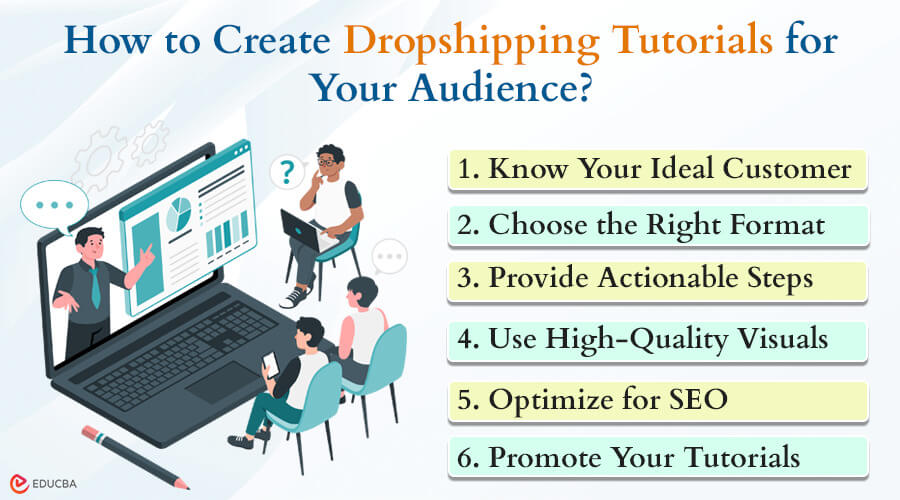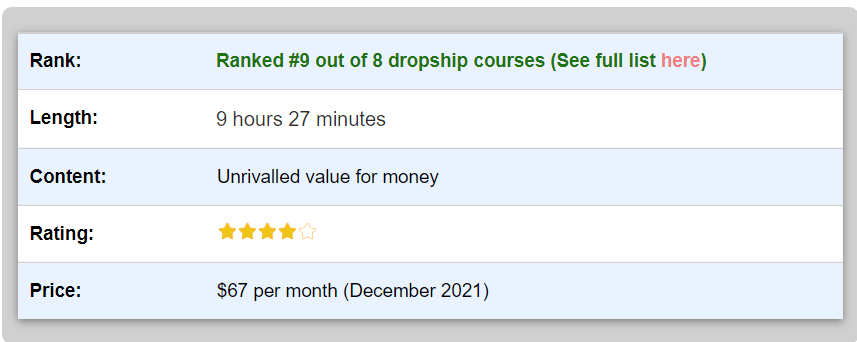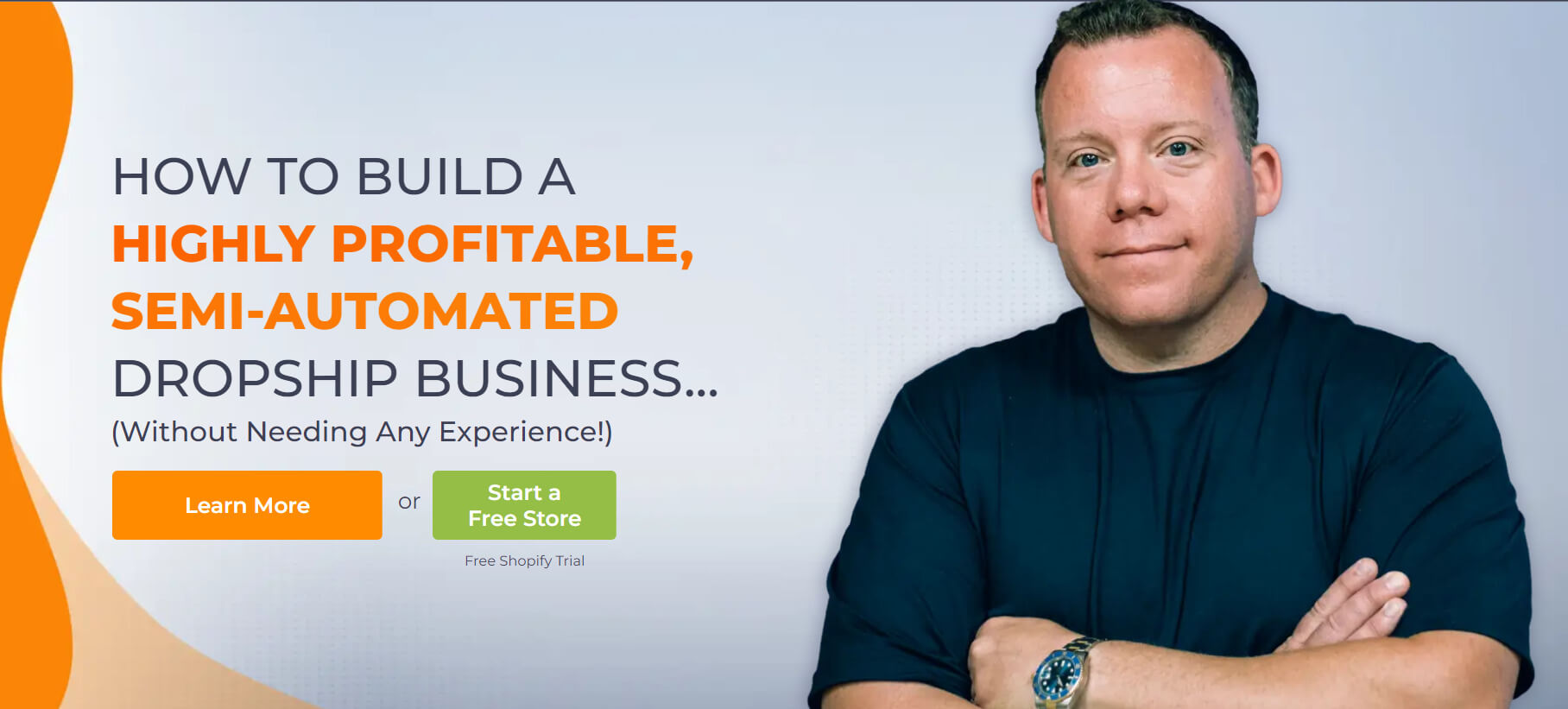
How to Create Dropshipping Tutorials? – Overview
Before we guide you through how to create dropshipping tutorials, let’s first see how creating tutorials will help your dropshipping business.
Starting a dropshipping business is not easy, as there’s much to learn. But, once you have created your position in the market, you can share your knowledge of the business with newcomers.
Apart from using standard marketing strategies, a strategy that stands out is educational content marketing. Educational content marketing positions you as the go-to expert in your niche. Creating helpful guides attracts customers, builds trust, and establishes your brand’s authority. This sets you apart in a busy market and gives people a reason to choose you over others.
This guide will explain how to create dropshipping tutorials to help those new to dropshipping grow their own businesses.
What Do You Understand by Dropshipping Business?
A dropshipping business is a retail business in which the seller keeps no inventory. Instead, when the seller gets an order, they buy the product from a third party (often a wholesaler or manufacturer) and directly ship it to the customer. The seller doesn’t deal with the product directly. This model allows people to start an online store with minimal upfront investment without requiring warehousing products. Utilizing a free dropshipper can further reduce costs and make it easier for new entrepreneurs to enter the market
How to Create Dropshipping Tutorials for Your Audience?
Matt Grammer, Founder & CEO of Counseling Now, adds, “Creating tutorials that resonate with aspiring dropshippers requires more than just sharing information.”
So, let’s discuss them.
#1. Know Your Ideal Customer
Before you start, understand who you are making the tutorial for.
- What are their challenges?
- What is their knowledge level?
- Are they complete beginners, or do they have some experience with e-commerce?
“Once you understand their needs and challenges, you can customize your content accordingly. Beginners might need more basic, step-by-step tutorials on setting up a store or choosing a product, while more experienced drop shippers might be looking for advanced strategies for scaling or finding niche markets”, adds Alex Taylor, Head of Marketing at CrownTV.
Customizing your content ensures it remains relevant and valuable to all skill levels, keeping your audience engaged. Regularly updating and expanding your tutorials to address evolving trends and new tools in the dropshipping industry will also show your commitment to their ongoing success.
#2. Choose the Right Format
Tutorials can take many forms, so choose what suits your content and audience.
- Video: Videos are great for showing processes or demonstrating software use. They can be more engaging and easier for visual learners to follow.
- Written Guides: In-depth articles or blog posts are perfect for complex topics or step-by-step instructions that people can easily refer to.
- Infographics: If your tutorial is data-heavy or involves a multi-step process, infographics can help break down complex information visually appealingly.
- Audio: Podcasts or audio recordings can offer a convenient way for people to learn on the go.
#3. Provide Actionable Steps
Don’t just talk about concepts in theory. Break down your tutorials into clear, actionable steps that people can easily follow. Use numbered lists, bullet points, and clear language to guide your audience through each stage of the process.
#4. Use High-Quality Visuals
“Whether you are creating videos or written guides, visuals are key. Use high-resolution images, screenshots, or diagrams to make your tutorials more engaging. If you are making videos, invest in decent lighting and sound equipment for a professional look,” says Jimi Gecelter, CEO of Tradeit.gg. Clear and visually appealing content helps maintain viewer interest and improves the overall learning experience. Consistently using high-quality visuals also enhances your brand’s credibility and professionalism.
#5. Optimize for SEO
Incorporate important and relevant keywords into your titles, descriptions, and throughout your content. This will help your tutorials rank higher in search results and attract organic traffic.
#6. Promote Your Tutorials
Don’t just create great content and hope it gets found. Eran Mizrahi, CEO of Ingredient Brothers, says, “Actively promote your tutorials on your social media channels, in email newsletter, and consider running paid ads to reach a wider audience.”
Partnering with other dropshippers or influencers to cross-promote each other’s tutorials. Furthermore, use multiple promotional strategies and ensure that your tutorials reach the right audience and maximize their impact.
#7. Keep it Engaging
Make your tutorials interesting. Use storytelling techniques, humor, or relatable anecdotes to entertain your audience. Add quizzes, polls, or interactive elements to encourage participation.
#8. Gather Feedback
After you publish a tutorial, ask your audience for feedback. What did they like? What could be improved? Use this feedback to refine your future content and ensure it meets your audience’s needs.
#9. Stay Consistent
Don’t just create one tutorial and call it a day. Commit to regularly publishing educational content to keep your audience engaged and coming back for more. Create a content calendar to plan out your tutorials and stay on track.
Types of Tutorials That Resonate with Dropshippers
Tutorials come in various formats and cover a range of topics. To make the most of your educational content, first, understand which types of tutorials your audience finds most valuable. Here are some of the most popular options for aspiring dropshippers.
#1. Step-by-Step Guides/Blogs
The step-by-step guide provides detailed, actionable instructions on essential aspects of dropshipping. Topics could include.
- How to set up a store from scratch
- Choosing a profitable niche
- Finding winning products to sell
- Creating effective product descriptions
- Setting up Facebook ad campaigns
- Managing customer service.
#2. Video Tutorials
“Videos offer a more engaging and visual way to learn. They are particularly effective for demonstrating technical tasks or giving people a behind-the-scenes look at your business,” adds Alison Lancaster, CEO of Pressat.co.uk.
Popular formats for dropshipping video tutorials include.
- Screen-share tutorials showing how to use specific software or tools
- Showcase popular dropshipping items with product demos highlighting their features and benefits
- “Day in the life” vlogs sharing your daily routines and experiences as a dropshipper.
#3. Troubleshooting/FAQ Content
“New dropshippers are bound to face challenges and have plenty of questions. Understand their challenges and create tutorials that address those specific issues,” mentions Khashayar Shahnazari, Chief Executive Officer at FinlyWealth.
This could include.
- How to deal with shipping delays
- Tips for handling customer complaints
- Common mistakes to avoid in dropshipping
#4. Case Studies/Success Stories
“Everyone loves a success story. Sharing real-life examples of other dropshippers who have achieved their goals is incredibly inspiring,” says Chase Hughes, Founder of ProAI.
You can,
- Interview successful dropshippers and share their journeys
- Create case studies highlighting specific strategies or tactics that led to success
- Share your own experiences and lessons as a dropshipper
Remember, variety is key. By offering a mix of different types of tutorials, you will cater to different learning styles and keep your audience engaged. Don’t be afraid to experiment with various formats and see what resonates best with your particular niche.
Why Educational Content Gives Dropshipping Businesses a Real Edge?
Here’s why educational content is so valuable for dropshipping businesses.
#1. Builds Trust and Credibility
Imagine browsing through different online stores for a new pair of shoes. One store simply bombards you with flashy images and slogans, pushing you to buy without offering any real information. Another store, however, takes the time to explain how to choose the right shoe size, offers styling tips, and even provides guides on how to care for different types of shoes.
Which store would you trust more? Most likely, you would lean towards the one that goes beyond just selling products by providing valuable information and assistance.
“So, when you create educational content like tutorials and guides, you show customers that you are not just in it for a quick sale. You are sharing your expertise and genuine desire to help them succeed. This builds trust and makes your brand an authority in the dropshipping space,” adds Saba Mobebpour, CEO at Dropshipping Suppliers US.
#2. Attracts the Right Kind of Traffic
When you offer tutorials like “Choosing a Profitable Niche” or “Setting Up Your Shopify Store,” you draw in people interested in starting a business like yours. While they may not be ready to buy right away, they see you as a helpful guide on their path to entrepreneurship. Eventually, many of them will likely become paying customers because they trust your expertise and find your content valuable.
#3. Boosts Your Search Engine Rankings
Search engines like Google prefer high-quality, informative content. Martin Seeley, CEO of Mattress Next Day, says, “When you consistently create helpful tutorials, it boosts your website search result ranking. This means more visibility, more organic traffic, and more customers finding your store.” Additionally, well-structured and keyword-optimized tutorials can improve your SEO performance, which makes it easier for potential customers to discover your content. Regularly updating your tutorials with fresh information and relevant keywords can further enhance your search engine rankings and keep your audience engaged.
#4. Provides Long-Term Value That Keeps on Giving
Unlike a flash sale or a one-time promotion, educational content has lasting value. Those in-depth guides and tutorials you create today will attract traffic and generate leads for months or even years to come. This is known as “evergreen content” — it stays relevant and valuable over time.
Real-World Examples of Successful Dropshipping Tutorials
Here are some popular real-world examples.
#1. Case Study 1: Wholesale Ted’s Dropshipping Guides and Community
(Image Source: Ippei)
Sarah Chrisp, known online as Wholesale Ted, is a leading figure in the dropshipping world, known for her comprehensive YouTube channel and online courses. She’s built a thriving business by focusing on educational content that guides aspiring dropshippers through every step of the process.
What she does well:
- Variety of Formats: Wholesale Ted offers a mix of video tutorials, blog posts, podcasts, and even paid courses, catering to different learning styles and preferences.
- In-Depth Content: Her tutorials go beyond the basics, covering advanced topics like product research, Facebook Ads, and scaling strategies.
- Strong Community: She fosters a vibrant online community where dropshippers can connect, ask questions, and share their experiences.
- Personal Brand: Wholesale Ted’s personality shines through in her content, making her relatable and trustworthy.
Results:
- Wholesale Ted’s YouTube channel boasts hundreds of thousands of subscribers and millions of views.
- Her educational content has helped her build a multi-million-dollar dropshipping empire.
- She’s cultivated a dedicated community of dropshippers who value her expertise and guidance.
#2. Case Study 2: The Dropship Lifestyle Blog and Coaching Program
(Image Source: Drop Ship Lifestyle)
Anton Kraly, the founder of The Dropship Lifestyle, has built a multi-million dollar business through a combination of in-depth blog posts, YouTube videos, and a comprehensive coaching program. His content focuses on teaching a specific methodology for building successful dropshipping stores that sell high-ticket items.
What they do well:
- Targeted Niche: The Dropship Lifestyle caters specifically to those interested in the “high-ticket dropshipping” model, offering highly relevant content and resources.
- In-Depth Blog: Their blog is a wealth of information, covering everything from niche selection and supplier relationships to building and scaling a profitable store.
- YouTube Presence: Anton Kraly regularly posts videos on his YouTube channel, offering tutorials, interviews with successful dropshippers, and live Q&A sessions.
- Paid Coaching Program: For those seeking more hands-on guidance, The Dropship Lifestyle offers a comprehensive coaching program that includes personalized mentorship and access to a private community.
Results:
Here are some benefits he got.
- The Dropship Lifestyle has a track record of producing successful dropshipping entrepreneurs, with many students achieving six-figure or even seven-figure incomes.
- The brand has become synonymous with high-ticket dropshipping, attracting a dedicated audience of aspiring entrepreneurs.
- The business model extends beyond just educational content, incorporating coaching, community, and even software tools, creating multiple revenue streams.
#3. Case Study 3: Biaheza’s Dropshipping Course and Community
(Image Source: Biaheza’s Full Dropshipping Course)
Biaheza, a successful dropshipping entrepreneur, offers a comprehensive dropshipping course and a supportive community for aspiring entrepreneurs. His content primarily focuses on Facebook Ads, product research, and building a profitable e-commerce business.
What he does well:
- Comprehensive Course: Biaheza’s flagship course is a deep dive into dropshipping fundamentals and advanced strategies. It includes video lessons, templates, and case studies to guide students through the process of building a successful store.
- Active Community: He hosts a private Facebook group exclusively for his students, creating a space for them to ask questions, share their wins and challenges, and get support from both Biaheza and their peers.
- Transparency and Authenticity: Biaheza openly shares his own experiences and struggles, making him relatable and inspiring to his audience. He also showcases real results from his students, demonstrating the effectiveness of his teachings.
Results:
- The private Facebook group has thousands of members who actively participate in discussions and support each other on their dropshipping journeys.
- Many of Biaheza’s students have gone on to create profitable dropshipping stores, thanks to the knowledge and support they gained through his course and community.
- Biaheza has established himself as a respected figure in the dropshipping community. He is known for his expertise and willingness to share his knowledge.
#4. Case Study 4: Oberlo’s Dropshipping Blog and Resources
(Image Source: Oberlo)
Oberlo, a popular dropshipping platform owned by Shopify, has used educational content to build a massive community of dropshippers and establish themselves as a leading authority in the field.
What they do well:
- Comprehensive Blog: Oberlo’s blog is a treasure trove of information covering all aspects of dropshipping, from beginner guides to advanced marketing strategies. They publish articles regularly, ensuring fresh content that keeps readers coming back for more.
- Free Resources: Oberlo offers a variety of free resources, including ebooks, webinars, and checklists, to help dropshippers succeed. These resources provide practical tips and actionable steps that beginners can easily follow.
- Case Studies: Oberlo showcases real-life success stories of dropshippers who have used their platform and resources to build profitable businesses. This inspires and motivates their audience, showing them what’s possible.
- Community Building: They have a strong social media presence and an active Facebook group where dropshippers can connect, share ideas, and ask questions. This fosters a sense of community and support, which is essential for new entrepreneurs.
Results:
- Oberlo’s blog and resources attract a large audience of aspiring and established dropshippers, generating significant traffic to their platform.
- Their free resources act as lead magnets, attracting potential customers who may eventually sign up for Oberlo’s paid plans.
- By consistently providing valuable educational content, Oberlo has become a trusted source of information for dropshippers.
- Their educational content strategy has undoubtedly contributed to Oberlo’s overall growth and success as a leading dropshipping platform.
Final Thoughts
“Creating tutorials for aspiring dropshippers isn’t just about showing off what you know — it’s about building genuine connections and helping others succeed. When you share expertise through informative, engaging content, you establish yourself as a trusted authority in the dropshipping community and attract potential customers who value knowledge,” says Ali Nahhas, Owner of Aladdins Houston.
Learning how to create drop shipping tutorials pays off in the long run. Your tutorials will continue to draw in a steady stream of interested people, and your brand will gain recognition for its helpfulness and expertise.
It’s a win-win strategy that sets the stage for long-term growth and success in the dropshipping competitive world.
Recommended Articles
We hope you found this article on ‘How to Create Dropshipping Tutorials’ informative. The following recommendations can help you learn about similar concepts.




